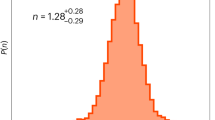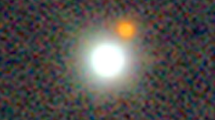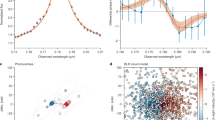Abstract
The concordance model (Λ cold dark matter (ΛCDM) model, where Λ is the cosmological constant) reproduces the main current cosmological observations1,2,3,4 assuming the validity of general relativity at all scales and epochs and the presence of CDM and of Λ, equivalent to dark energy with a constant density in space and time. However, the ΛCDM model is poorly tested in the redshift interval between the farthest observed type Ia supernovae5 and the cosmic microwave background. We present measurements of the expansion rate of the Universe based on a Hubble diagram of quasars. Quasars are the most luminous persistent sources in the Universe, observed up to redshifts of z ≈ 7.5 (refs. 6,7). We estimate their distances following a method developed by our group8,9,10, based on the X-ray and ultraviolet emission of the quasars. The distance modulus/redshift relation of quasars at z < 1.4 is in agreement with that of supernovae and with the concordance model. However, a deviation from the ΛCDM model emerges at higher redshift, with a statistical significance of ~4σ. If an evolution of the dark energy equation of state is allowed, the data suggest dark energy density increasing with time.
This is a preview of subscription content, access via your institution
Access options
Access Nature and 54 other Nature Portfolio journals
Get Nature+, our best-value online-access subscription
$29.99 / 30 days
cancel any time
Subscribe to this journal
Receive 12 digital issues and online access to articles
$119.00 per year
only $9.92 per issue
Buy this article
- Purchase on Springer Link
- Instant access to full article PDF
Prices may be subject to local taxes which are calculated during checkout




Similar content being viewed by others
Data availability
The data that support the plots within this paper and other findings of this study are available from the corresponding author upon reasonable request.
References
Planck Collaboration et al. Planck 2015 results. XIII. Cosmological parameters. Astron. Astrophys. 594, A13 (2016).
Betoule, M. et al. Improved cosmological constraints from a joint analysis of the SDSS-II and SNLS supernova samples. Astron. Astrophys. 568, A22 (2014).
Aubourg, E. et al. Cosmological implications of baryon acoustic oscillation measurements. Phys. Rev. D 22, 123516 (2015).
Mantz, A. B. et al. Cosmology and astrophysics from relaxed galaxy clusters. II. Cosmological constraints. Mon. Not. R. Astron. Soc. 440, 2077–2098 (2014).
Suzuki, N. et al. The Hubble Space Telescope Cluster Supernova Survey. V. Improving the dark-energy constraints above z > 1 and building an early-type-hosted supernova sample. Astrophys. J. 746, 85 (2012).
Mortlock, D. J. et al. A luminous quasar at a redshift of z = 7.085. Nature 474, 616–619 (2011).
Bañados, E. et al. An 800-million-solar-mass black hole in a significantly neutral Universe at a redshift of 7.5. Nature 553, 473–476 (2018).
Risaliti, G. & Lusso, E. A Hubble diagram for quasars. Astrophys. J. 815, 33 (2015).
Lusso, E. & Risaliti, G. The tight relation between X-ray and ultraviolet luminosity of quasars. Astrophys. J. 819, 154 (2016).
Lusso, E. & Risaliti, G. Quasars as standard candles. I. The physical relation between disc and coronal emission. Astron. Astrophys. 602, A79 (2017).
Shakura, N. I. & Sunyaev, R. A. Black holes in binary systems. Observational appearance. Astron. Astrophys. 24, 337–355 (1973).
Avni, Y. & Tananbaum, H. X-ray properties of optically selected QSOs. Astrophys. J. 305, 83–99 (1986).
Just, D. W. et al. The X-ray properties of the most luminous quasars from the Sloan Digital Sky Survey. Astrophys. J. 665, 1004–1022 (2007).
Lusso, E. et al. The X-ray to optical-UV luminosity ratio of X-ray selected type 1 AGN in XMM-COSMOS. Astron. Astrophys. 512, A34 (2010).
Young, M., Risaliti, G. & Elvis, M. The X-ray energy dependence of the relation between optical and X-ray emission in quasars. Astrophys. J. 708, 1388–1397 (2010).
Jansen, F. et al. XMM-Newton observatory. I. The spacecraft and operations. Astron. Astrophys. 365, L1–L6 (2001).
Rosen, S. R. et al. The XMM-Newton serendipitous survey. VII. The third XMM-Newton serendipitous source catalogue. Astron. Astrophys. 590, A1 (2016).
Shen, Y. et al. A catalog of quasar properties from Sloan Digital Sky Survey data release 7. Astrophys. J. Suppl. S. 194, 45 (2011).
Paris, I. et al. The Sloan Digital Sky Survey quasar catalog: twelfth data release. Astron. Astrophys. 597, A79 (2017).
Kalfountzou, E. et al. The largest X-ray-selected sample of z > 3 AGNs: C-COSMOS and ChaMP. Mon. Not. R. Astron. Soc. 445, 1430–1448 (2014).
Vagnetti, F., Antonucci, M. & Trevese, D. Variability and the X-ray/UV ratio of active galactic nuclei. II. Analysis of a low-redshift Swift sample. Astron. Astrophys. 550, A71 (2013).
Brusa, M. et al. The XMM-Newton wide-field survey in the COSMOS field (XMM-COSMOS): demography and multiwavelength properties of obscured and unobscured luminous active galactic nuclei. Astrophys. J. 716, 348–369 (2010).
Paolillo, M. et al. Tracing the accretion history of supermassive black holes through X-ray variability: results from the ChandraDeep Field-South. Mon. Not. R. Astron. Soc. 471, 4398–4411 (2017).
MacLeod, C. et al. A description of quasar variability measured using repeated SDSS and POSS imaging. Astrophys. J. 753, 106 (2012).
Riess, A. G. et al. A 2.4% determination of the local value of the Hubble constant. Astrophys. J. 826, 56 (2016).
Planck Collaboration et al. Planck 2015 results. XIV. Dark energy and modified gravity. Astron. Astrophys. 594, A14 (2016).
Riess, A. G. et al. Type Ia supernova distances at redshift >1.5 from the Hubble Space Telescope Multi-cycle Treasury programs: the early expansion rate. Astrophys. J. 853, 126 (2018).
Gibson, R. R., Brandt, W. N., Gallagher, S. C. & Schneider, D. P. A catalog of broad absorption line quasars in Sloan Digital Sky Survey data release 5. Astrophys. J. 692, 758–777 (2009).
Mingo, B. et al. The MIXR sample: AGN activity versus star formation across the cross-correlation of WISE, 3XMM, and FIRST/NVSS. Mon. Not. R. Astron. Soc. 462, 2631–2667 (2016).
Hasinger, G. et al. The XMM-Newton wide-field survey in the COSMOS field. I. Survey description. Astrophys. J. Suppl. S. 172, 29–37 (2007).
Cappelluti, N. et al. The XMM-Newton wide-field survey in the COSMOS field. The point-like X-ray source catalogue. Astron. Astrophys. 497, 635–648 (2009).
Nanni, R., Vignali, C., Gilli, R., Moretti, A. & Brandt, W. N. The X-ray properties of z ~ 6 luminous quasars. Astron. Astrophys. 603, A128 (2017).
Green, P. J. et al. The soft X-ray properties of a large optical QSO sample: ROSAT observations of the Large Bright Quasar Survey. Astrophys. J. 450, 51 (1995).
Gallagher, S. C., Brandt, W. N., Sambruna, R. M., Mathur, S. & Yamasaki, N. Exploratory ASCA observations of broad absorption line quasi-stellar objects. Astrophys. J. 519, 549–555 (1999).
Brandt, W. N., Laor, A. & Wills, B. J. On the nature of soft X-ray weak quasi-stellar objects. Astrophys. J. 528, 649 (2000).
Hewett, P. C. & Foltz, C. B. The frequency and radio properties of broad absorption line quasars. Astron. J. 125, 1784–1794 (2003).
Richards, G. T. et al. Red and reddened quasars in the Sloan Digital Sky Survey. Astron. J. 126, 1131–1147 (2003).
Merloni, A. et al. The incidence of obscuration in active galactic nuclei. Mon. Not. R. Astron. Soc. 437, 3550–3567 (2014).
Bianchi, S. et al. CAIXA: a catalogue of AGN in the XMM-Newton archive. I. Spectral analysis. Astron. Astrophys. 495, 421–430 (2009).
Prevot, M. L., Lequeux, J., Maurice, E., Prevot, L. & Rocca-Volmerange, B. The typical interstellar extinction in the Small Magellanic Cloud. Astron. Astrophys. 132, 389–392 (1984).
Watson, M. G. et al. The XMM-Newton Serendipitous Survey. I. The role of XMM-Newton Survey Science Centre. Astron. Astrophys. 365, L51–L59 (2001).
Foreman-Mackey, D., Hogg, D. W., Lang, D. & Goodman, J. emcee: the MCMC hammer. Publ. Astron. Soc. Pac. 126, 306 (2013).
Kelly, B. C. Some aspects of measurement error in linear regression of astronomical data. Astrophys. J. 665, 1489–1506 (2007).
Zheng, W., Kriss, G. A., Telfer, R. C., Grimes, J. P. & Davidsen, A. F. A composite HST spectrum of quasars. Astrophys. J. 475, 469–478 (1997).
Lusso, E. et al. The first ultraviolet quasar-stacked spectrum at z ~ 2.4 from WFC3. Mon. Not. R. Astron. Soc. 449, 4204–4220 (2015).
Tilton, E. M., Stevans, M. L., Shull, J. M. & Danforth, C. W. HST-COS observations of AGNs. III. Spectral constraints in the Lyman continuum from composite COS/G140L data. Astrophys. J. 817, 56 (2016).
Shull, J. M., Danforth, C. W., Tilton, E. M., Moloney, J. & Stevans, M. L. An ultraviolet survey of low-redshift partial Lyman-limit systems with the HST Cosmic Origins Spectrograph. Astrophys. J. 849, 106 (2017).
Stevans, M. L., Shull, J. M., Danforth, C. W. & Tilton, E. M. HST-COS observations of AGNs. II. Extended survey of ultraviolet composite spectra from 159 active galactic nuclei. Astrophys. J. 794, 75 (2014).
Acknowledgements
We are grateful to our collaborators S. Bisogni, M. Elvis, R. Gilli, E. Nardini, M. Salvati, F. Salvestrini and C. Vignali for discussions and comments on the main topics of this work. G.R. acknowledges the support of grant ASI-INAF no. 2017–14-H.0. E.L. is supported by a European Union COFUND/Durham Junior Research Fellowship (under EU grant agreement no. 609412). This work has made use of data from the SDSS, SDSS-II and SDSS-III surveys, of the 3XMM Source Catalog and of XMM-Newton and Chandra observations. Funding for the SDSS and SDSS-II has been provided by the Alfred P. Sloan Foundation, the Participating Institutions, the National Science Foundation, the United States Department of Energy, the National Aeronautics and Space Administration, the Japanese Monbukagakusho, the Max Planck Society and the Higher Education Funding Council for England. The SDSS website is http://www.sdss.org/. The SDSS is managed by the Astrophysical Research Consortium for the Participating Institutions. The Participating Institutions are the American Museum of Natural History, Astrophysical Institute Potsdam, University of Basel, University of Cambridge, Case Western Reserve University, University of Chicago, Drexel University, Fermilab, the Institute for Advanced Study, the Japan Participation Group, Johns Hopkins University, the Joint Institute for Nuclear Astrophysics, the Kavli Institute for Particle Astrophysics and Cosmology, the Korean Scientist Group, the Chinese Academy of Sciences (LAMOST), Los Alamos National Laboratory, the Max Planck Institute for Astronomy (MPIA), the Max Planck Institute for Astrophysics (MPA), New Mexico State University, Ohio State University, University of Pittsburgh, University of Portsmouth, Princeton University, the United States Naval Observatory and the University of Washington. Funding for SDSS-III has been provided by the Alfred P. Sloan Foundation, the Participating Institutions, the National Science Foundation and the US Department of Energy Office of Science. The SDSS-III website is http://www.sdss3.org/. SDSS-III is managed by the Astrophysical Research Consortium for the Participating Institutions of the SDSS-III Collaboration including the University of Arizona, the Brazilian Participation Group, Brookhaven National Laboratory, Carnegie Mellon University, University of Florida, the French Participation Group, the German Participation Group, Harvard University, the Instituto de Astrofisica de Canarias, the Michigan State/Notre Dame/JINA Participation Group, Johns Hopkins University, Lawrence Berkeley National Laboratory, the Max Planck Institute for Astrophysics, the Max Planck Institute for Extraterrestrial Physics, New Mexico State University, New York University, Ohio State University, Pennsylvania State University, University of Portsmouth, Princeton University, the Spanish Participation Group, University of Tokyo, University of Utah, Vanderbilt University, University of Virginia, University of Washington and Yale University.
Author information
Authors and Affiliations
Contributions
Both authors contributed equally to the scientific content and the writing of this paper.
Corresponding author
Ethics declarations
Competing interests
The authors declare no competing interests.
Additional information
Publisher’s note: Springer Nature remains neutral with regard to jurisdictional claims in published maps and institutional affiliations.
Supplementary information
Supplementary Information
Supplementary Text, Supplementary Figures 1–17, Supplementary References 1–38
Rights and permissions
About this article
Cite this article
Risaliti, G., Lusso, E. Cosmological constraints from the Hubble diagram of quasars at high redshifts. Nat Astron 3, 272–277 (2019). https://doi.org/10.1038/s41550-018-0657-z
Received:
Accepted:
Published:
Issue Date:
DOI: https://doi.org/10.1038/s41550-018-0657-z
This article is cited by
-
Varying vacuum models with spatial curvature: a dynamical system perspective
General Relativity and Gravitation (2024)
-
Microlensing of Strongly Lensed Quasars
Space Science Reviews (2024)
-
A comparison of cosmological models with high-redshift quasars
Astrophysics and Space Science (2023)
-
Cosmology with the Laser Interferometer Space Antenna
Living Reviews in Relativity (2023)
-
X-ray astronomy comes of age
Nature (2022)



